Class 10 SELINA Solutions Maths Chapter 6 - Solving (simple) Problems (Based on Quadratic Equations)
Solving (simple) Problems (Based on Quadratic Equations) Exercise Ex. 6(A)
Solution 1(a)
Correct Option: (iii) 2 and 3
Let the natural numbers be x and 5 – x
Hence, sum of its reciprocals

Solution 1(b)
Correct Option: (iv) 4 and 6
Let numbers be x and (x+2).
Product = 24
Hence,
x(x+2) = 24
∴ x2 + 2x – 24 = 0
∴ (x+6)(x-4)=0
∴ x = -6 and x = 4
As x is a whole number, hence x = 4
Thus numbers are 4 and 6.
Solution 1(c)
Correct Option: (ii) 4 and 5 or -4 and -5
Let x and (x+1) are two integers.
Hence,
x2 + (x+1)2 = 41
∴ x2 + x2 + 2x + 1 = 41
∴ 2x2 + 2x - 40 = 0
∴ x2 + x - 20 = 0
∴(x+5)(x-4)=0
∴ x = -5 or x = 4
∴ Integers are -5 and -4 or 4 and 5.
Solution 1(d)
Correct Option: (i) 5 or 
Let the number be x.
Hence,

Solution 1(e)
Correct Option: (iv) -4 and -6 or 6 and 4
Let integers be x and x + 2.
Hence.
x2 + (x+2)2 = 52
∴ 2x2 + 4x + 4 – 52 = 0
∴ x2 + 2x + 2 – 26 = 0
∴ x2 + 2x – 24 = 0
∴ (x+6)(x-4)=0
∴ x = -6 or x = 4
∴ Integers are -6 and -4 or 6 and 4.
Solution 1(f)
Correct Option: (i) 5
Work done by A in one day = 1/5
Work done by B in one day = ![]()
Days required to complete the work together = ![]() days.
days.
Thus work completed in one day together = ![]()
Hence,

Solution 2
Let the two numbers be x and x + 5.
From the given information,
x2 + (x + 5)2 = 97
2x2 + 10x + 25 - 97 = 0
2x2 + 10x - 72 = 0
x2 + 5x - 36 = 0
(x + 9) (x - 4) = 0
x = -9 or 4
Since, -9 is not a natural number. So, x = 4.
Thus, the numbers are 4 and 9.
Solution 3
Let the two parts be x and x - 15.

x = 5 ![]() One part = 5 and other part = 10
One part = 5 and other part = 10
x = 10 ![]() One part = 10 and other part = 5
One part = 10 and other part = 5
Thus, the required two parts are 5 and 10.
Solution 4
Let the two numbers be x and y, y being the bigger number. From the given information,
x2 + y2 = 208 ..... (i)
y2 = 18x ..... (ii)
From (i), we get y2=208 - x2. Putting this in (ii), we get,
208 - x2 = 18x
![]() x2 + 18x - 208 = 0
x2 + 18x - 208 = 0
![]() x2 + 26X - 8X - 208 = 0
x2 + 26X - 8X - 208 = 0
![]() x(x + 26) - 8(x + 26) = 0
x(x + 26) - 8(x + 26) = 0
![]() (x - 8)(x + 26) = 0
(x - 8)(x + 26) = 0
![]() x can't be a negative number , hence x = 8
x can't be a negative number , hence x = 8
![]() Putting x = 8 in (ii), we get y2 = 18 x 8=144
Putting x = 8 in (ii), we get y2 = 18 x 8=144
![]() y = 12, since y is a positive integer
y = 12, since y is a positive integer
Hence, the two numbers are 8 and 12.
Solution 5
Let the consecutive positive odd numbers be x and x + 2.
From the given information,
x2 + (x + 2)2 = 74
2x2 + 4x + 4 = 74
2x2 + 4x - 70 = 0
x2 + 2x - 35 = 0
(x + 7)(x - 5) = 0
x = -7, 5
Since, the numbers are positive, so, x = 5.
Thus, the numbers are 5 and 7.
Solution 6
Let the required fraction be![]() .
.
From the given information,

Since, the fraction is positive, x = 2
Thus, the required fraction is ![]() .
.
Solution 7
Given, three positive numbers are in the ratio![]()
Let the numbers be 6x, 4x and 3x.
From the given information,
(6x)2 + (4x)2 + (3x)2 = 244
36x2 + 16x2 + 9x2 = 244
61x2 = 244
x2 = 4
x = ![]()
Since, the numbers are positive, so x = 2.
Thus, the numbers are 12, 8 and 6.
Solution 8
Let the two parts be x and y.
From the given information,
x + y = 20 ![]()
3x2 = (20 - x) + 10
3x2 = 30 - x
3x2 + x - 30 = 0
3x2 - 9x + 10x - 30 = 0
3x(x - 3) + 10(x - 3) = 0
(x - 3) (3x + 10) = 0
x = 3, ![]()
Since, x cannot be equal to![]() , so, x = 3.
, so, x = 3.
Thus, one part is 3 and other part is 20 - 3 = 17.
Solution 9
Let the numbers be x - 1, x and x + 1.
From the given information,
x2 = (x + 1)2 - (x - 1)2 + 60
x2 = x2 + 1 + 2x - x2 - 1 + 2x + 60
x2 = 4x + 60
x2 - 4x - 60 = 0
(x - 10) (x + 6) = 0
x = 10, -6
Since, x is a natural number, so x = 10.
Thus, the three numbers are 9, 10 and 11.
Solution 10
Let the numbers be p - 1, p and p + 1.
From the given information,
3(p + 1)2 = (p - 1)2 + p2 + 67
3p2 + 6p + 3 = p2 + 1 - 2p + p2 + 67
p2 + 8p - 65 = 0
(p + 13)(p - 5) = 0
p = -13, 5
Since, the numbers are positive so p cannot be equal to -13.
Thus, p = 5.
Solution 11
Work done by A in one day = ![]()
Work done by B in one day = ![]()
Together A and B can do the work in 15 days. Therefore, we have:

Since, x cannot be negative.
Thus, x = 24.
Solution 12
Let one pipe fill the cistern in x hours and the other fills it in (x - 3) hours.
Given that the two pipes together can fill the cistern in 6 hours 40 minutes, i.e., ![]()

If x =![]() , then x - 3 =
, then x - 3 =![]() , which is not possible.
, which is not possible.
So, x = 15.
Thus, one pipe fill the cistern in 15 hours and the other fills in (x - 3) = 15 - 3 = 12 hours.
Solution 13
Let the smaller part be x.
Then, (larger part)2 = 8x
\ larger part = ![]()
Now, the sum of the squares of both the terms is given to be 208

Thus, the required number is 2 + 4 = 6.
Solving (simple) Problems (Based on Quadratic Equations) Exercise Ex. 6(B)
Solution 1(a)
Correct Option: (ii) 4 m and 10 m
Let length of rectangle be x m
Hence, breadth will be ![]() m
m

Thus, x = 10 or 4
And sides are 10 m and 4 m.
Solution 1(b)
Correct Option: (i) 6 m
By Pythagoras theorem
x2 + (x+2)2 = 100
∴ 2x2 + 4x + 4 = 100
∴ x2 + 2x + 2 = 50
∴ x2 + 2x - 48 = 0
∴ (x + 8) (x – 6) = 0
∴ x = -8 or x = 6
As sides can’t be negative, ∴ x = 6.
Solution 1(c)
Correct Option: (iii) 32 m
Let shorter side be x
We have,
10x = 60
∴ x = 6
∴ Perimeter = 2 (10 + 6) = 32
Solution 1(d)
Correct Option: (iv) 16 units
Let side of square be x.
Thus,
x2 = 4x
∴ x = 4
Perimeter = 4x = 16 units.
Solution 1(e)
Correct Option: (i) 320 m2 - (16 - 2x) × (20 - 2x) m2
Length of inner rectangle = (20 – 2x) m
Breadth of inner rectangle = (16 – 2x) m
Area of inner rectangle = (16 – 2x)(20 – 2x)
Thus area of shaded portion = 320 - (16 – 2x)(20 – 2x)
Solution 2

Area of triangle = 30 cm2

But, x cannot be negative, so x = 3.
Thus, we have:
AB = 4 ![]() 3 cm = 12 cm
3 cm = 12 cm
BC = (2 ![]() 3 - 1) cm = 5 cm
3 - 1) cm = 5 cm
CA = ![]() (Using Pythagoras theorem)
(Using Pythagoras theorem)
Solution 3
Longer side = Hypotenuse = (3x + 1) cm
Lengths of other two sides are (x - 1) cm and 3x cm.
Using Pythagoras theorem,
(3x + 1)2 = (x - 1)2 + (3x)2
9x2 + 1 + 6x = x2 + 1 - 2x + 9x2
x2 - 8x = 0
x(x - 8) = 0
x = 0, 8
But, if x = 0, then one side = 3x = 0, which is not possible.
So, x = 8
Thus, the lengths of the sides of the triangle are (x - 1) cm = 7 cm, 3x cm = 24 cm and (3x + 1) cm = 25 cm.
Area
of the triangle = ![]()
Solution 4
Let the hypotenuse of a triangle be x cm.
From the given information,
Length of one side = (x - 1) cm
Length of other side = (x - 18) cm
Using Pythagoras theorem,
x2 = (x - 1)2 + (x - 18)2
x2 = x2 + 1 - 2x + x2 + 324 - 36x
x2 - 38x + 325 = 0
x2 - 13x - 25x + 325 = 0
x(x - 13) - 25(x - 13) = 0
(x - 13) (x - 25) = 0
x = 13, 25
When x = 13, x - 18 = 13 - 18 = -5, which being negative, is not possible.
So, x = 25
Thus, the lengths of the sides of the triangle are x = 25 cm, (x - 1) = 24 cm and (x - 18) = 7 cm.
Solution 5

Let the shorter side be x m.
Length of the other side = (x + 30) m
Length of hypotenuse = (x + 60) m
Using Pythagoras theorem,
(x + 60)2 = x2 + (x + 30)2
x2 + 3600 + 120x = x2 + x2 + 900 + 60x
x2 - 60x - 2700 = 0
x2 - 90x + 30x - 2700 = 0
x(x - 90) + 30(x - 90) = 0
(x - 90) (x + 30) = 0
x = 90, -30
But, x cannot be negative. So, x = 90.
Thus, the sides of the rectangle are 90 m and (90 + 30) m = 120 m.
Solution 6
Let the length and the breadth of the rectangle be x m and y m.
Perimeter = 2(x + y) m
![]() 104 = 2(x + y)
104 = 2(x + y)
x + y = 52
y = 52 - x
Area = 640 m2
![]() xy = 640
xy = 640
x(52 - x) = 640
x2 - 52x + 640 = 0
x2 - 32x - 20x + 640 = 0
x(x - 32) - 20 (x - 32) = 0
(x - 32) (x - 20) = 0
x = 32, 20
When x = 32, y = 52 - 32 = 20
When x = 20, y = 52 - 20 = 32
Thus, the length and breadth of the rectangle are 32 m and 20 m.
Solution 7
Let w be the width of the footpath.

Area of the path = Area of outer rectangle - Area of inner rectangle
![]() 208 = (32)(24)
- (32 - 2w)(24 - 2w)
208 = (32)(24)
- (32 - 2w)(24 - 2w)
208 = 768 - 768 + 64w + 48w - 4w2
4w2 - 112w + 208 = 0
w2 - 28w + 52 = 0
w2 - 26w - 2w + 52 = 0
w(w - 26) - 2(w - 26) = 0
(w - 26) (w - 2) = 0
w = 26, 2
If w = 26, then breadth of inner rectangle = (24 - 52) m = -28 m, which is not possible.
Hence, the width of the footpath is 2 m.
Solution 8
Let the width of the gravel path be w m.
Length of the rectangular field = 50 m
Breadth of the rectangular field = 40 m
Let the length and breadth of the flower bed be x m and y m respectively.
Therefore, we have:
x + 2w = 50 ... (1)
y + 2w = 40 ... (2)
Also, area of rectangular field = 50 m ![]() 40 m = 2000 m2
40 m = 2000 m2
Area of the flower bed = xy m2
Area of gravel path = Area of rectangular field - Area of flower bed = (2000 - xy) m2
Cost of laying flower bed + Gravel path = Area x cost of laying per sq. m
![]() 52000 = 30
52000 = 30 ![]() xy + 20
xy + 20 ![]() (2000 - xy)
(2000 - xy)
52000 = 10xy + 40000
xy = 1200
Using (1) and (2), we have:
(50 - 2w) (40 - 2w) = 1200
2000 - 180w + 4w2 = 1200
4w2 - 180w + 800 = 0
w2 - 45w + 200 = 0
w2 - 5w - 40w + 200 = 0
w(w - 5) - 40(w - 5) = 0
(w - 5) (w - 40) = 0
w = 5, 40
If w = 40, then x = 50 - 2w = -30, which is not possible.
Thus, the width of the gravel path is 5 m.
Solution 9
Let the size of the larger tiles be x cm.
Area of larger tiles = x2 cm2
Number of larger tiles required to pave an area is 128.
So, the area needed to be paved = 128 x2 cm2 .... (1)
Size of smaller tiles = (x - 2)cm
Area of smaller tiles = (x - 2)2 cm2
Number of larger tiles required to pave an area is 200.
So, the area needed to be paved = 200 (x - 2)2 cm2 .... (2)
Therefore, from (1) and (2), we have:
128 x2 = 200 (x - 2)2
128 x2 = 200x2 + 800 - 800x
72x2 - 800x + 800 = 0
9x2 - 100x + 100 = 0
9x2 - 90x - 10x + 100 = 0
9x(x - 10) - 10(x - 10) = 0
(x - 10)(9x - 10) = 0
x = 10, ![]()
If ![]() , then
, then ![]() , which is not possible.
, which is not possible.
Hence, the size of the larger tiles is 10 cm.
Solution 10
Let the length and breadth of the rectangular sheep pen be x and y respectively.
From the given information,
x + y + x = 70
2x + y = 70 ... (1)
Also, area = xy = 600
Using (1), we have:
x (70 - 2x) = 600
70x - 2x2 = 600
2x2 - 70x + 600 = 0
x2 - 35x + 300 = 0
x2 - 15x - 20x + 300 = 0
x(x - 15) - 20(x - 15) = 0
(x - 15)(x - 20) = 0
x = 15, 20
If x = 15, then y = 70 - 2x = 70 - 30 = 40
If x = 20, then y = 70 - 2x = 70 - 40 = 30
Thus, the length of the shorter side is 15 m when the longer side is 40 m. The length of the shorter side is 20 m when the longer side is 30 m.
Solution 11
Let the side of the square lawn be x m.
Area of the square lawn = x2 m2
The square lawn is bounded on three sides by a path which is 4 m wide.
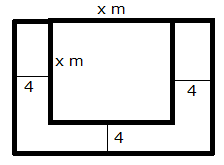
Area of outer rectangle = (x + 4) (x + 8) = x2 + 12x + 32
Area of path = x2 + 12x + 32 - x2 = 12x + 32
From the given information, we have:

Since, x cannot be negative. So, x = 16 m.
Thus, each side of the square lawn is 16 m.
Solution 12
Let the original length and breadth of the rectangular room be x m and y m respectively.
Area of the rectangular room = xy = 300
![]()
New length = (x - 5) m
New breadth = (y + 5) m
New area = (x - 5) (y + 5) = 300 (given)
Using (1), we have:

But, x cannot be negative. So, x = 20.
Thus, the length of the room is 20 m.
Solving (simple) Problems (Based on Quadratic Equations) Exercise Ex. 6(C)
Solution 1(a)
Correct Option: (iv) 24 km/h
Speed upstream = Speed of boat – speed of stream
=32 – 8
= 24 km/hr
Solution 1(b)
Correct Option: (iii) 

Solution 1(c)
Correct Option: (iii) 15 or 25
Let the number of girls be x
Hence, the number of boys is 40 – x
Thus,
x(40 – x) = 375
∴40x – x2 = 375
∴x2 – 40x + 375 = 0
∴(x-25)(x-15)=0
∴ x = 25 or x = 15
Hence, the number of girls will be 15 or 25.
Thus, the number of boys will be 25 or 15.....(40 - 15 = 25; 40 - 25 = 15)
Hence, the correct option is (iii).
Note: The correct option provided at the back of the textbook does not match the above solution.
Solution 1(d)
Correct Option: (iii) Rs. 40
SP = CP + profit

∴ x = -140 and x = 40
Since, cost can’t be negative, we have x = 40.
Solution 1(e)
Correct Option: (ii) 20

x is positive as it denotes percentage, thus x = 20.
Solution 2
(i) Speed of ordinary train = x km/hr
Speed of express train = (x + 25) km/hr
Distance = 300 km
We know:
![]()
![]() Time taken by ordinary train to cover 300 km =
Time taken by ordinary train to cover 300 km = ![]()
Time taken by express train to cover 300 km = ![]()
(ii) Given that the ordinary train takes 2 hours more than the express train to cover the distance.
Therefore,

But, speed cannot be negative. So, x = 50.
![]() Speed of the express train = (x + 25) km/hr = 75 km/hr
Speed of the express train = (x + 25) km/hr = 75 km/hr
Solution 3
Let the speed of the car be x km/hr.
Distance = 36 km
Time taken to cover a distance of 36 km = ![]()
![]()
New speed of the car = (x + 10) km/hr
New time taken by the car to cover a distance of 36 km = ![]()
From the given information, we have:

But, speed cannot be negative.
So, x = 30.
Hence, the original speed of the car is 30 km/hr.
Solution 4
Let the original speed of the aeroplane be x km/hr.
Time taken to cover a distance of 1200 km = ![]()
![]()
Let the new speed of the aeroplane be (x - 40) km/hr.
Time taken to cover a distance of 1200 km = ![]()
From the given information, we have:

But, speed cannot be negative. So, x = 400.
Thus, the original speed of the aeroplane is 400 km/hr.
Solution 5
Let x km/h be the original speed of the car.
We know that,
![]()
It is given that the car covers a distance of 400 km with the speed of x km/h.
Thus, the time taken by the car to complete 400 km is
![]()
Now, the speed is increased by 12 km.
![]()
Also given that, increasing the speed of the car will decrease the time taken by 1 hour 40 minutes.
Hence,


Solution 6
We know:
![]()
Given, the girl covers a distance of 6 km at a speed x km/ hr.
Time taken to cover first 6 km = ![]()
Also, the girl covers the remaining 6 km distance at a speed (x + 2) km/ hr.
Time taken to cover next 6 km = ![]()
Total time taken to cover the whole distance = 2 hrs 30 mins = ![]()

Since, speed cannot be negative. Therefore, x = 4.
Solution 7
Let the speed of goods train be x km/hr. So, the speed of express train will be (x + 20) km/hr.
Distance = 1040 km
We know:
![]()
Time taken by goods train to cover a distance of 1040 km = ![]()
Time taken by express train to cover a distance of 1040 km = ![]()
It is given that the express train arrives at a station 36 minutes before the goods train. Also, the express train leaves the station 2 hours after the goods train. This means that the express train arrives at the station ![]() before the goods train.
before the goods train.
Therefore, we have:

Since, the speed cannot be negative. So, x = 80.
Thus, the speed of goods train is 80 km/hr and the speed of express train is 100 km/hr.
Solution 8
C.P. of the article = Rs x
S.P. of the article = Rs 16
Loss = Rs (x - 16)
We know:


Thus, the cost price of the article is Rs 20 or Rs 80.
Solution 9
C.P. of the article = Rs x
S.P. of the article = Rs 52
Profit = Rs (52 - x)
We know:
![]()

Since, C.P. cannot be negative. So, x = 40.
Thus, the cost price of the article is Rs 40.
Solution 10
Let the C.P. of the chair be Rs x
S.P. of chair = Rs 75
Profit = Rs (75 - x)
We know:

But, C.P. cannot be negative. So, x = 50.
Hence, the cost of the chair is Rs 50.
Solving (simple) Problems (Based on Quadratic Equations) Exercise Ex. 6(D)
Solution 1(a)
Correct Option: (ii) 7 and 5
35 = 7⨉5
Also both 7 and 5 is greater than 4.
Hence, the correct option is (ii).
Solution 1(b)
Correct Option: (iv) 64
Let the units and tens place digits be x - 2 and x respectively.
x(x-2)=24
∴x2-2x -24 = 0
∴(x-6)(x+4)=0
∴x = 6 or x = -4
Since digits are positive, hence x = 6, so number is 64.
Solution 1(c)
Correct Option: (i) 46
Let the unit place digit be x
Then tens place digit will be 24/x

Now, after adding 18, digits get reversed

Digits are always positive, thus x = 6, so number is 46.
Solution 1(d)
Correct Option: (iii) 25 years and 10 years
Let present age of Radha = x
Then present age of Meena = 39 – x
By given condition

Thus,
Present age of Radha = 27
Present age of Meena = 12
Two years ago,
Age of Radha = 25
Age of Meena = 10
Solution 1(e)
Correct Option: (iii) Rs. 8 less
Amount received per student = 320÷8 = 40
After addition of 8 more students
Amount received per student = 320÷10 = 32
Thus each student would receive Rs. 8 less.
Solution 2
Let the ten's and unit's digit of the required number be x and y respectively.
From the given information,

The digit of a number cannot be negative, so, x = 3.
![]()
Thus, the required number is 38.
Solution 3
The ages of two sisters are 11 years and 14 years.
Let in x number of years the product of their ages be 304.

But, the number of years cannot be negative. So, x = 5.
Hence, the required number of years is 5 years.
Solution 4
Let the present age of the son be x years.
![]() Present age of man = x2 years
Present age of man = x2 years
One year ago,
Son's age = (x - 1) years
Man's age = (x2 - 1) years
It is given that one year ago; a man was 8 times as old as his son.
![]() (x2 - 1) = 8(x - 1)
(x2 - 1) = 8(x - 1)
x2 - 8x - 1 + 8 = 0
x2 - 8x + 7 = 0
(x - 7) (x - 1) = 0
x = 7, 1
If x = 1, then x2 = 1, which is not possible as father's age cannot be equal to son's age.
So, x = 7.
Present age of son = x years = 7 years
Present age of man = x2 years = 49 years
Solution 5
Let the present age of the son be x years.
![]() Present age of father = 2x2 years
Present age of father = 2x2 years
Eight years hence,
Son's age = (x + 8) years
Father's age = (2x2 + 8) years
It is given that eight years hence, the age of the father will be 4 years more than three times the age of the son.
![]() 2x2 + 8 = 3(x + 8) +4
2x2 + 8 = 3(x + 8) +4
2x2 + 8 = 3x + 24 +4
2x2 - 3x - 20 = 0
2x2 - 8x + 5x - 20 = 0
2x(x - 4) + 5(x - 4) = 0
(x - 4) (2x + 5) = 0
x = 4, ![]()
But, the age cannot be negative, so, x = 4.
![]() Present age of son = 4 years
Present age of son = 4 years
Present age of father = 2(4)2 years = 32 years
Solution 6
Number of oranges = y
Cost of one orange =![]()
The servant ate 3 oranges, so Mr. Mehra received (y - 3) oranges.
So, x = y - 3 ![]() y = x + 3 ...(1)
y = x + 3 ...(1)
Cost of one orange paid by Mr. Mehra = ![]()
=![]()
Now, Mr. Mehra pays a total of Rs 15.

But, the number of oranges cannot be negative. So, x = 12.
Solution 7
Let the number of children be x.
It is given that Rs 250 is divided amongst x students.
So, money received by each child = Rs![]()
If there were 25 children more, then
Money received by each child = Rs![]()
From the given information,

Since, the number of students cannot be negative, so, x = 100.
Hence, the number of students is 100.
Solution 8
Original weekly wage of each worker = Rs x
Original weekly wage bill of employer = Rs 3150
Number of workers = ![]()
New weekly wage of each worker = Rs (x + 5)
New weekly wage bill of employer = Rs 3250
Number of workers = ![]()
From the given condition,

Since, wage cannot be negative, x = 45.
Thus, the original weekly wage of each worker is Rs 45.
Solution 9
Number of articles bought by the trader = x
It is given that the trader bought the articles for Rs. 1200.
So, cost of one article = Rs.![]()
Ten articles were damaged. So, number of articles left = x - 10
Selling price of each of (x - 10) articles = Rs.![]()
Selling price of (x - 10) articles = Rs. (x - 10) ![]()
Profit = Rs. 60

Number of articles cannot be negative. So, x = 100.
Solution 10
Let the number of articles bought be x.
Total cost price of x articles = Rs 4800
Cost price of one article = Rs![]()
Selling price of each article = Rs 100
Selling price of x articles = Rs 100x
Given, Profit = C.P. of 15 articles
![]() 100x - 4800 = 15
100x - 4800 = 15 ![]()
100x2 - 4800x = 15 ![]() 4800
4800
x2 - 48x - 720 = 0
x2 - 60x + 12x - 720 = 0
x(x - 60) + 12(x - 60) = 0
(x - 60) (x + 12) = 0
x = 60, -12
Since, number of articles cannot be negative. So, x = 60.
Thus, the number of articles bought is 60.
Solving (simple) Problems (Based on Quadratic Equations) Exercise TEST YOURSELF
Solution 1(a)
Correct Option: (ii) 4 or 
Let the number be x.

Solution 1(b)
Correct Option: (i) 15 and 3
Let one whole number be x.
Then other one will be 18 – x.
Thus
x(18-x)=45
∴x2 -18x + 45 = 0
∴(x-15)(x-3)=0
∴ x = 15 or x = 3
Solution 1(c)
Correct Option: (iii) 15 m
Let breadth is x m,
Hence length will be x + 3 m
Area = x(x+3)
Hence,
∴x2 + 3x – 180 = 0
∴ (x +15)(x – 12) =0
∴ x = -15 or x = 12
As length can’t be negative, hence x = 12m which is breadth, so length will be 15 m.
Solution 1(d)
Correct Option: (iii) 

Solution 1(e)
Correct Option: (ii) 6 hrs
Let pipe1 fills the cistern in x hrs, hence, pipe2 will fill it in (x + 3) hrs.
Part of cistern filled in 1 hr by pipe 1 = ![]()
Hence, part of cistern filled in 1 hr by pipe 2 = ![]()
Thus, together in 1 hr they will fill ½ part

∴(x-3)(x+2)=0
∴x = 3 and x = -2
As time can’t be negative, x = 3hrs, which is time taken by pipe 1.
Thus time taken by pipe 2 = 6hrs
Solution 2
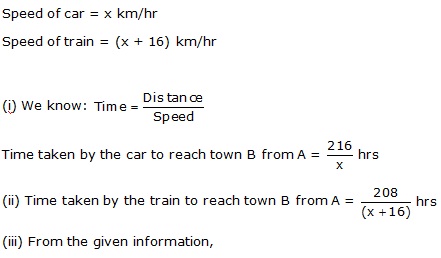
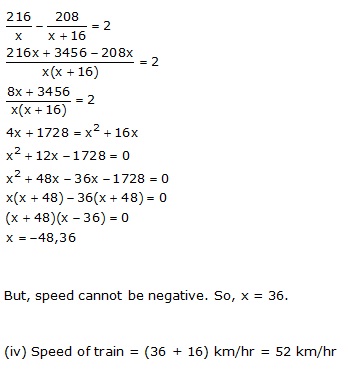
Solution 3
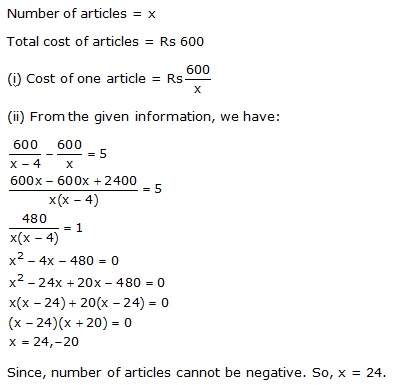
Solution 4
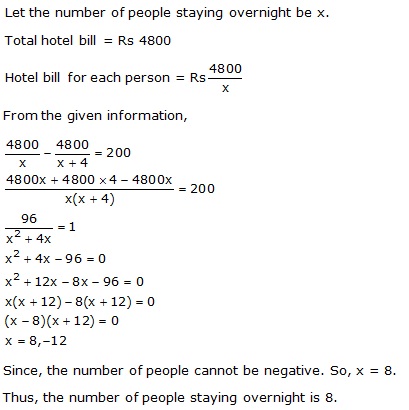
Solution 5
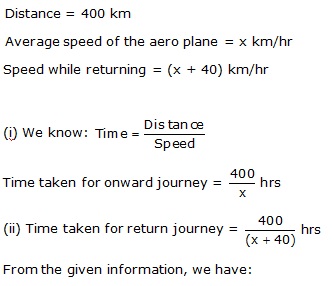
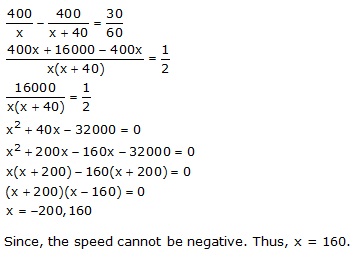
Solution 6

Solution 7
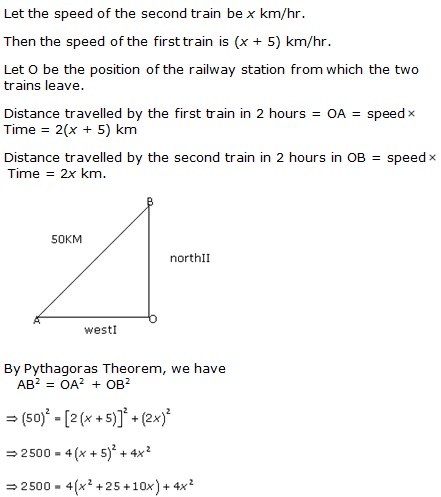
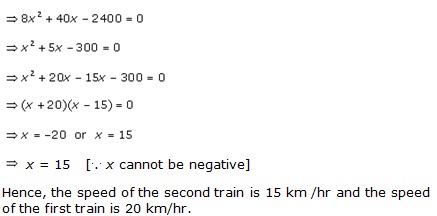
Solution 8
Let the present ages of father and his son be x years and (45 - x) years respectively.
Five years ago,
Father's age = (x - 5) years
Son's age = (45 - x - 5) years = (40 - x) years
From the given information, we have:
(x - 5) (40 - x) = 124
40x - x2 - 200 + 5x = 124
x2 - 45x +324 = 0
x2 - 36x - 9x +324 = 0
x(x - 36) - 9(x - 36) = 0
(x - 36) (x - 9) = 0
x = 36, 9
If x = 9,
Father's age = 9 years, Son's age = (45 - x) = 36 years
This is not possible.
Hence, x = 36
Father's age = 36 years
Son's age = (45 - 36) years = 9 years
Solution 9
Let the number of rows in the original arrangement be x.
Then, the number of seats in each row in original arrangement = x
Total number of seats =![]()
From the given information,
2x(x - 10) = x2 + 300
2x2 - 20x = x2 + 300
x2 - 20x - 300 = 0
(x - 30) (x + 10) = 0
x = 30, -10
Since, the number of rows or seats cannot be negative. So, x = 30.
(i) The number of rows in the originalarrangement = x = 30
(ii) The number of seats after re-arrangement = x2 + 300 = 900 + 300 = 1200
Solution 10
Let the age of son 2 years ago be x years.
Then, father's age 2 years ago = 3x2 years
Present age of son = (x + 2) years
Present age of father = (3x2 + 2) years
3 years hence:
Son's age = (x + 2 + 3) years = (x + 5) years
Father's age = (3x2 + 2 + 3) years = (3x2 + 5) years
From the given information,
3x2 + 5 = 4(x + 5)
3x2 - 4x - 15 = 0
3x2 - 9x + 5x - 15 = 0
3x(x - 3) + 5(x - 3) = 0
(x - 3) (3x + 5) = 0
x = 3,
Since, age cannot be negative. So, x = 3.
Present age of son = (x + 2) years = 5 years
Present age of father = (3x2 + 2) years = 29 years
Solution 11
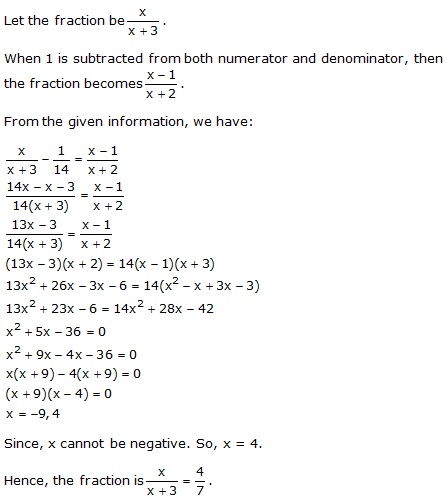
Solution 12
Given, the difference between two digits is 6 and the ten's digit is bigger than the unit's digit.
So, let the unit's digit be x and ten's digit be (x + 6).
From the given condition, we have:
x(x + 6) = 27
x2 + 6x - 27 = 0
x2 + 9x - 3x - 27 = 0
x(x + 9) - 3(x + 9) = 0
(x + 9) (x - 3) = 0
x = -9, 3
Since, the digits of a number cannot be negative. So, x = 3.
Unit's digit = 3
Ten's digit = 9
Thus, the number is 93.
Solution 13
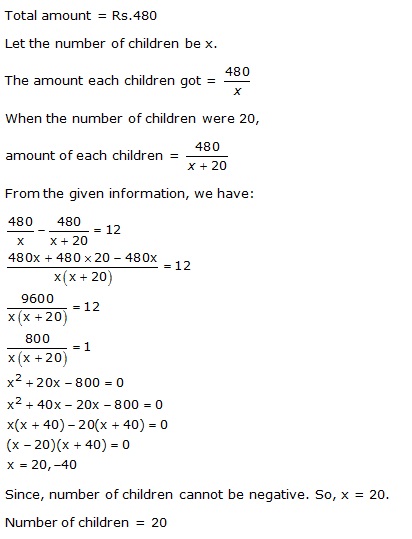
Solution 14
Given that he sum of the ages of Vivek and his younger brother Amit is 47 years.
Let the age of Vivek = x
⇒ the age of Amit = 47 - x
The product of their ages in years is 550 …. given
⇒ x(47 - x) = 550
⇒ 47x - x2 = 550
⇒ x2 - 47x + 550 = 0
⇒ x2 - 25x - 22x + 550 = 0
⇒ x(x - 25) - 22(x - 25) = 0
⇒ (x - 25) (x - 22) = 0
⇒ x = 25 or x = 22
Given that Vivek is an elder brother.
∴ x = 25 years = age of Vivek and
age of Amit = 47 - 25 = 22 years

